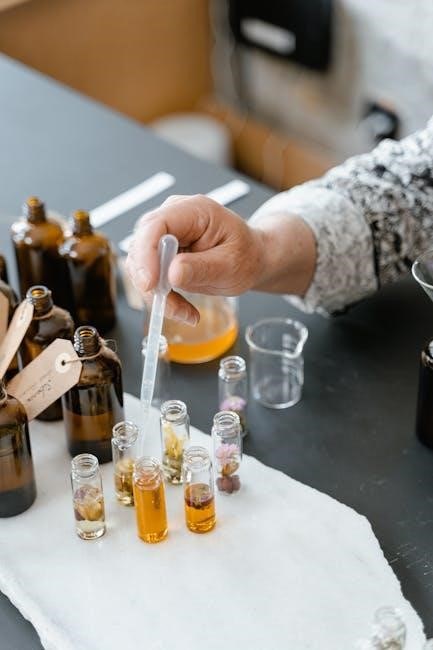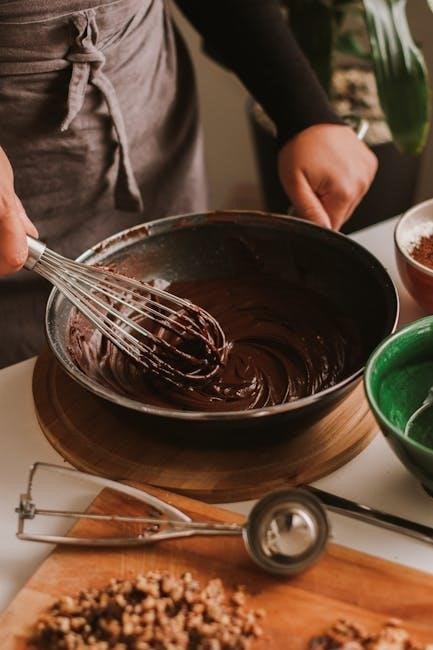Permethrin 13.3 is a synthetic insecticide, part of the pyrethroid family, effective against a wide range of pests; It is commonly used in agricultural, livestock, and outdoor applications.
Derived from natural extracts, it offers a dual action, providing both quick knockdown and residual control. Proper mixing is essential for safety and efficacy.
1.1 What is Permethrin 13.3?
Permethrin 13.3 is a synthetic insecticide concentrate, part of the pyrethroid family, derived from natural pyrethrins. It contains 13.3% active permethrin, making it a versatile solution for pest control. Widely used in agriculture, livestock, and outdoor applications, it is applied as a spray to target insects effectively, offering both quick knockdown and residual effects.
1.2 Common Uses of Permethrin 13.3
Permethrin 13.3 is widely used in agriculture to protect crops from pests. It is also applied in livestock farming to control ticks, flies, and mites. Additionally, it is used for outdoor pest control, treating areas like lawns, gardens, and kennels. Its versatility makes it a popular choice for both farm and residential applications, ensuring effective pest management across various settings.

Importance of Proper Mixing
Proper mixing ensures the correct concentration, balancing safety and effectiveness. It prevents over-dilution, which reduces efficacy, and under-dilution, which can pose health risks. Accurate mixing is crucial for reliable pest control results.
2.1 Safety Considerations
Proper mixing of Permethrin 13.3 requires wearing protective gear, including gloves, goggles, and a mask. Avoid skin contact and inhalation of fumes. Ensure the area is well-ventilated. Never mix near open flames or sparks. Keep the product away from pets and children. Always follow label instructions to minimize health risks and environmental impact. Accurate dilution prevents overexposure to the active ingredient.
2.2 Effectiveness of Proper Dilution
Proper dilution ensures optimal insecticidal activity, maximizing pest control while minimizing risks. Correct mixing ratios prevent under-dilution, which may reduce efficacy, and over-dilution, which can harm surfaces or the environment. Accurate concentration maintains residual effects, ensuring long-lasting protection against pests. Properly mixed solutions also reduce the risk of chemical resistance, making treatments more effective over time and enhancing overall efficiency.

Mixing Ratios for Permethrin 13.3
Common dilution rates vary between 0.25% and 0.50%. For general use, mix 2 2/3 to 5 1/2 ounces per gallon of water, depending on the application.

3.1 General Mixing Ratios
Permethrin 13.3 is typically mixed at a 0.25% to 0.50% dilution rate. For most applications, use 2 2/3 to 5 1/2 ounces per gallon of water. This ensures effective pest control while maintaining safety. Always refer to the product label for precise ratios tailored to specific uses, such as agricultural or outdoor treatments, and follow all safety guidelines.
3.2 Specific Ratios for Different Applications
For tick control, mix 2 2/3 ounces per gallon. In livestock settings, use 8 ounces in 8.25 gallons to treat kennels and yards. For agricultural use, ratios vary based on pest severity, from 0.25% to 0.50% dilution. Always adjust concentrations according to the target pest and application site to ensure optimal results and compliance with label instructions.
Step-by-Step Mixing Instructions
Measure the concentrate accurately, add it to water in a partially filled tank, mix thoroughly, and fill the tank to the desired volume. Ensure even distribution for optimal effectiveness.
4.1 Measuring the Concentrate
Accurately measure Permethrin 13.3 concentrate using a calibrated measuring cup or syringe. For most applications, 2 2/3 to 5 1/2 ounces per gallon of water is recommended. Always refer to the product label for specific dosing instructions. Double-check measurements to avoid over- or under-dilution, ensuring safety and effectiveness. Precision is key to achieving the desired concentration for optimal pest control results.
4.2 Adding to Water
Add the measured Permethrin 13.3 concentrate to water in a well-ventilated area. Fill the mixing tank halfway with water, then pour in the concentrate. Avoid adding water to the concentrate, as this can cause uneven mixing. Complete filling the tank and ensure thorough agitation to achieve a uniform solution. This step is critical for maintaining the product’s effectiveness and safety.
4.3 Agitation and Mixing
After adding Permethrin 13.3 to water, agitate the mixture thoroughly to ensure even distribution. For manual mixing, stir the solution continuously for 2-3 minutes. For automatic systems, follow the manufacturer’s agitation guidelines to prevent settling. Proper mixing ensures uniformity and maintains the product’s effectiveness. Always maintain agitation during application to avoid uneven distribution and ensure optimal pest control results.
Equipment Needed for Mixing
Essential equipment includes a clean sprayer, mixing tank, measuring cups or jugs, and agitation tools. Ensure all gear is pesticide-compatible to prevent contamination and chemical reaction.
5.1 Sprayers and Tanks
Use a clean, sturdy sprayer or mixing tank specifically designed for pesticides. Stainless steel or heavy-duty plastic tanks are ideal. Ensure the sprayer is calibrated correctly to maintain accurate mixing ratios. Avoid using equipment that has previously contained other chemicals to prevent cross-contamination. Choose a tank with adequate capacity for the intended application volume.
5.2 Measuring Tools
Accurate measuring tools are crucial for proper dilution. Use a calibrated measuring cup or jug to ensure precise measurements of Permethrin 13.3 concentrate. For small batches, a 2-ounce measuring cup is ideal, while larger applications may require a 16-ounce or gallon-sized measuring container. Always double-check measurements to avoid over- or under-dilution, which can affect efficacy and safety.

Safety Precautions

Wear protective gloves, goggles, and clothing to avoid skin contact. Ensure good ventilation and avoid inhaling fumes during mixing. Handle spills immediately to prevent contamination.
6.1 Protective Gear
Wear long-sleeved shirts, pants, and waterproof gloves to prevent skin contact. Use goggles or safety glasses to protect eyes from splashes. Ensure clothing covers all exposed skin, and avoid open-toe shoes.

6.2 Handling Spills
Immediately isolate the spill area to prevent spread. Use sand or sawdust to absorb the liquid, then sweep up and dispose in a sealed container; Neutralize residue with soda ash solution. Avoid drainage into waterways. Wear protective gear during cleanup. Dispose of materials according to local regulations and safety guidelines to minimize environmental impact.
Common Mistakes to Avoid
Over-dilution reduces effectiveness, while under-dilution can pose safety risks. Always follow label instructions for precise mixing ratios to ensure optimal results and safety.
7.1 Over-Dilution
Over-dilution occurs when too much water is added, reducing the solution’s potency. This weakens its ability to kill pests effectively and leaves insufficient residual activity. Always measure carefully and follow the recommended mixing ratios to avoid this common mistake, ensuring optimal pest control and safety.
7.2 Under-Dilution
Under-dilution occurs when insufficient water is added, resulting in a concentrated solution that may damage plants or surfaces. This can also lead to regulatory violations and reduced effectiveness. Always adhere to the recommended mixing ratios to ensure safety and efficacy, avoiding potential harm to treated areas and ensuring optimal pest control results.

Applications of Mixed Permethrin 13.3
Mixed Permethrin 13.3 is widely used in agriculture, livestock, and outdoor settings to control ticks, fleas, and pests. It ensures effective residual action for long-term protection.
8.1 Agricultural Use
Permethrin 13.3 is widely applied in agriculture to control pests like ticks, fleas, and mites on crops and farm premises. Its residual action ensures long-lasting protection for plants and livestock, making it a reliable choice for farmers to maintain healthy crop conditions and prevent pest infestations effectively.
8.2 Livestock Use
Permethrin 13.3 is commonly used on livestock to control pests like mites, lice, and ticks. It is applied to animal housing, such as barns and kennels, to ensure effective pest management. The solution is typically mixed at a rate of 8 ounces per 8.25 gallons of water for thorough coverage and long-lasting protection, ensuring the health and comfort of the animals.
8.3 Outdoor Use
Permethrin 13.3 is widely used outdoors to control pests like ticks, mosquitoes, and fleas in yards, gardens, and patios. Mixed at 2 2/3 to 5 1/2 ounces per gallon of water, it provides effective residual control on outdoor surfaces, ensuring a pest-free environment for recreational and functional spaces while maintaining safety for plants and humans when applied correctly.
Reentry and Drying Times
Reentry is allowed after the spray has dried, typically within 24 hours. Drying time varies by surface, with vegetation taking longer than hard surfaces to dry completely.
9.1 Reentry After Application
Reentry into treated areas is permitted once the permethrin 13.3 spray has fully dried. Typically, this takes 24 hours, but drying time may vary depending on weather conditions and surface type. Always ensure the solution is dry before allowing humans, pets, or livestock to reenter the area to avoid exposure risks.
9.2 Drying Time for Different Surfaces
Drying time for permethrin 13.3 varies by surface. Grass and soil typically dry within 30 minutes to 1 hour, while wood and concrete may take 1-2 hours. Fabric and upholstery require 2-4 hours. Ensure the solution is completely dry before reentry or use to avoid exposure risks. Environmental factors like humidity and temperature can extend drying times.

Storage and Disposal
Store permethrin 13.3 in a cool, dry place away from direct sunlight. Dispose of unused solution and containers according to local regulations and guidelines.
10.1 Storing Mixed Solution
Store the mixed permethrin 13.3 solution in a tightly sealed container, away from direct sunlight and heat sources. Keep it in a well-ventilated area to prevent vapor buildup. Ensure the container is labeled with the date and contents for easy identification.
Protect the solution from freezing temperatures to maintain its effectiveness. Store it away from crops, food, and areas where people or pets frequent to avoid accidental exposure.
10.2 Proper Disposal Methods
Dispose of unused or leftover permethrin 13.3 solution responsibly. Take it to a hazardous waste collection facility to prevent environmental contamination. Do not pour the solution down drains or dispose of it in regular trash.
Empty containers should be rinsed thoroughly and recycled if possible. Always follow local regulations and guidelines for pesticide disposal to ensure safety and compliance.
Troubleshooting Common Issues
Common issues include clogged nozzles and inconsistent results. Clean equipment regularly and ensure proper dilution ratios. Recheck mixing instructions to avoid errors.
11.1 Inconsistent Results
Inconsistent results often stem from improper dilution or application. Ensure accurate measurements and adherence to recommended mixing ratios. Double-check dilution rates and verify spray coverage. Inadequate agitation or uneven distribution can also cause variability. Always follow label instructions precisely to achieve consistent effectiveness and avoid under or over-application, which may lead to reduced pest control efficiency.
11.2 Equipment Clogging
Equipment clogging can occur due to improper dilution or sediment in the permethrin solution. Regularly clean nozzles and screens to ensure smooth flow. Use a filter when transferring the concentrate to prevent debris from entering the tank. Ensure thorough agitation and avoid leaving the solution unused for extended periods, as it may settle and cause blockages during application.
Adhering to proper mixing guidelines ensures safety and effectiveness when using Permethrin 13.3. Always follow the manufacturer’s instructions and take necessary precautions for optimal results and environmental protection.
12.1 Summary of Key Points
Proper mixing of Permethrin 13.3 is essential for safety and effectiveness. Always use the recommended dilution rates, such as 0.25% or 0.50%, depending on the application. Ensure accurate measurement and thorough mixing. Wear protective gear and follow all safety precautions to minimize risks. Adhere to the manufacturer’s guidelines for specific uses, such as agricultural, livestock, or outdoor applications, to achieve optimal results and environmental protection. Proper techniques are vital for consistent performance and safety.
12.2 Final Tips for Effective Use
For optimal results, always wear protective gear and ensure accurate measurements. Thoroughly mix the solution to maintain consistency. Apply during low pest activity and avoid spraying in direct sunlight. Follow the product label instructions precisely for specific use cases. Allow the solution to dry completely before reentry. Proper timing and technique will enhance effectiveness and safety.
